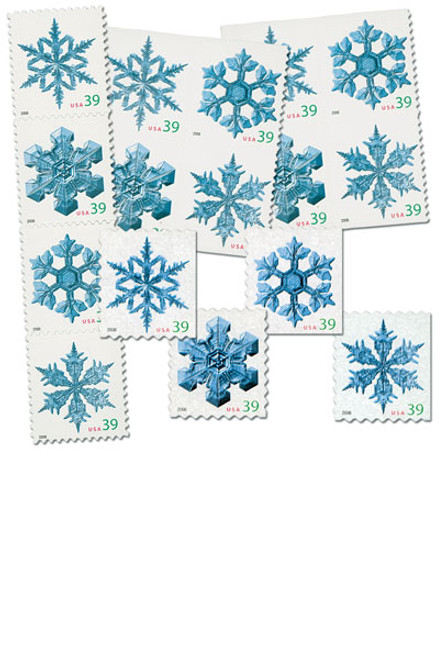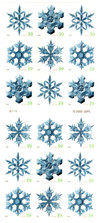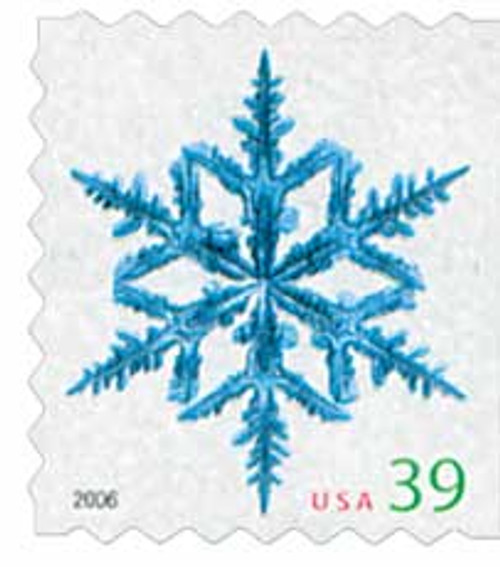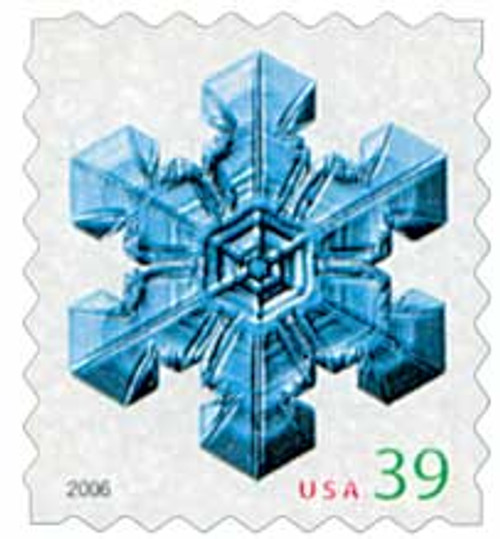
2006 39c Contemporary Christmas: Holiday Snowflakes, ATM booklet
# 4113-16 - 2006 39c Contemporary Christmas: Holiday Snowflakes, ATM booklet
$3.50 - $33.50
U.S. #4113-16
Holiday Snowflakes
Contemporary Christmas
Booklet, die cut 8
Holiday Snowflakes
Contemporary Christmas
Booklet, die cut 8
Issue Date: October 5, 2006
City: New York, NY
Quantity Issued: 54,000,000
City: New York, NY
Quantity Issued: 54,000,000
Snowflakes are composed of 2 to 200 separate snow crystals that have formed around tiny bits of dirt carried up into the atmosphere.
The snow crystals develop into one of four shapes depending on temperature. Six-pointed stars form at 3˚ to 10˚F. Flat, six-sided plates form at 10˚ to 18˚F and again between 27˚ to 32˚F. Six-sided columns form from 18˚ to 23˚, and needles form at 23˚ to 27˚F.
As a snow crystal grows, it becomes heavier and falls. The air and temperature around the crystal are constantly changing. Even a small change in these conditions can lead to different growth patterns. No two crystals have the same history, so no two are alike.
Falling snow crystals stick to one another to form snowflakes if they pass through warmer air. At very cold air temperatures, they do not stick together well. Thus, bitter-temperature snowfalls are composed mostly of snow crystals rather than snowflakes.
Snow crystals are typically only 0.02 to 0.2 inches across, while the average snowflake is about 0.4 inches across. Large flakes usually only grow when winds are very light. The biggest snowflake reported in the U.S. measured fifteen inches across. It fell on January 28, 1887, at Fort Keough, Montana.
U.S. #4113-16
Holiday Snowflakes
Contemporary Christmas
Booklet, die cut 8
Holiday Snowflakes
Contemporary Christmas
Booklet, die cut 8
Issue Date: October 5, 2006
City: New York, NY
Quantity Issued: 54,000,000
City: New York, NY
Quantity Issued: 54,000,000
Snowflakes are composed of 2 to 200 separate snow crystals that have formed around tiny bits of dirt carried up into the atmosphere.
The snow crystals develop into one of four shapes depending on temperature. Six-pointed stars form at 3˚ to 10˚F. Flat, six-sided plates form at 10˚ to 18˚F and again between 27˚ to 32˚F. Six-sided columns form from 18˚ to 23˚, and needles form at 23˚ to 27˚F.
As a snow crystal grows, it becomes heavier and falls. The air and temperature around the crystal are constantly changing. Even a small change in these conditions can lead to different growth patterns. No two crystals have the same history, so no two are alike.
Falling snow crystals stick to one another to form snowflakes if they pass through warmer air. At very cold air temperatures, they do not stick together well. Thus, bitter-temperature snowfalls are composed mostly of snow crystals rather than snowflakes.
Snow crystals are typically only 0.02 to 0.2 inches across, while the average snowflake is about 0.4 inches across. Large flakes usually only grow when winds are very light. The biggest snowflake reported in the U.S. measured fifteen inches across. It fell on January 28, 1887, at Fort Keough, Montana.












